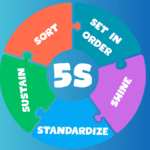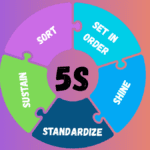
Spis treści
Introduction: Merging 5S with Lean Manufacturing
Implementing 5S and Lean together creates a robust framework for reducing waste, promoting continuous improvement, and enhancing operational efficiency. Rooted in lean manufacturing principles and the Toyota Production System, the 5S methodology—Sort, Set in Order, Shine, Standardize, Sustain—comprises five steps derived from Japanese words, each addressing a specific need in workplace organization. These five steps form the foundation of the 5S principles, which are implemented and standardized across organizations to ensure ongoing efficiency and operational excellence. In practice, these steps are used to systematically address operational needs by identifying what is used, organizing it, cleaning it, establishing standardized routines, and sustaining improvements.
Transform your shop floor: Enroll in our Lean 5S Training Course for expert-led guidance.
Sort: Clearing the Work Area for Lean Flow
The combined journey begins with Sort (Seiri), a process that involves categorizing items and things in the workspace. Only necessary items should remain, and each item should be evaluated to determine if it is still in use. During a red-tag event, teams identify and remove unnecessary items, obsolete documents, and broken equipment from the work area. One key question during this process is whether an item is still in use or still needed. Sorting frees up space and ensures that things are placed in their proper locations. Some items may be kept temporarily if their necessity is uncertain. This crucial step aligns with Lean’s focus on eliminating non-value-added activities.
Best Practices
- Tag items for removal, storage, or repair. Sorting is an important task that may involve several tasks, such as categorizing, labeling, and physically moving items.
- Ensure that all unnecessary items are identified and removed to maintain a well-organized workspace.
- Engage frontline employees to take ownership of their spaces.
- Document lessons for future 5S implementation and lean improvement.
Set in Order: Creating a Visual, Lean Workspace
Next, Set in Order (Seiton) organizes the remaining items so every tool and material has a designated location. The straightening step ensures all items are placed in their designated locations, making them easy to access and reducing wasted time searching. Using visual cues, shadow boards, and floor markings, you create a visual workplace that supports easy-to-find layouts and smooth lean flow. Different workspaces may require different ways of organizing tools and materials, and how items are placed can significantly impact workflow efficiency.
Key Actions
- Arrange tools by usage frequency to reduce time and unnecessary movement. For example, make your workspace more efficient by assigning each item, such as a frequently used wrench, a designated spot on a shadow board.
- Label storage with clear icons—“a place for everything.” Use visual cues, such as color-coded labels or outlines, to help identify where each item belongs.
- Integrate pull signals and Kanban cards to link 5S zones with the production process flow.
Streamline your layout with templates in our 5S Lean Training Course.
Visual Management: The Bridge Between 5S and Lean
Visual management is at the heart of both the 5S methodology and lean manufacturing, serving as the essential link that unites these two robust systems. By using visual cues—such as signs, labels, and charts—organizations can transform any work area into a visual workplace where information is clear, accessible, and actionable. This approach to workplace organization enables employees to easily understand their tasks, locate necessary tools and materials, and maintain a clean and efficient environment.
Implementing visual management means that every area of the workplace communicates its purpose at a glance. Employees can quickly see what is expected, making it easier for them to take ownership of their work and maintain an organized environment. Visual management not only supports the daily 5S routines but also reinforces lean principles by making processes transparent and reducing confusion and wasted time.
For organizations committed to lean and 5S, visual management is more than just a set of tools—it’s a methodology that creates a culture of clarity, accountability, and continuous improvement. By making the workplace visual, teams can work more effectively, maintain high standards, and drive ongoing success in manufacturing and beyond.
Shine, Standardize, and Sustain: Embedding Lean Discipline
Shine—cleaning and inspection—reveals hidden lean waste, aligns with daily Kaizen routines, and safeguards safety.
Standardize codifies these practices into a repeatable system of visual management. Standardized procedures and documentation are essential for sustaining improvements, as they ensure that improvements made are maintained over time. Standardizing practices also helps keep the workplace organized and efficient, directly supporting productivity. New improvements can be integrated into the standardized system to boost productivity further and maintain consistency.
Sustain ensures teams practice 5S daily, turning it into a continuous improvement habit. Sustaining the 5S system is crucial to maintaining productivity and preventing regression. To sustain 5S as an ongoing part of the organization’s culture, leadership support and employee involvement are necessary, ensuring that improvements are embedded and continuously enhanced.
Integrating Lean with Shine–Sustain
- Schedule daily Shine inspections alongside lean daily stand-ups, ensuring all team members are involved and specific tasks are assigned to support sustained 5S.
- Use visual controls to display audit results and lean KPIs, making it easy for the team to track progress and maintain standards.
- Encourage employee buy-in by recognizing lean and 5S champions, fostering a culture where people are engaged and committed to sustaining improvements through ongoing tasks and collaboration.
Beyond the First Three: A Holistic Lean-5S System
The first three S’s—Sort, Set in Order, Shine—lay the foundation. But true Lean 5S extends through Standardize and Sustain, harmonizing with broader lean tools. The full 5S principles are implemented across various workspaces—including digital, office, and production environments—to ensure consistent improvements and organizational efficiency. Sharing improvements across workspaces helps sustain progress and standardize best practices.
- Value Stream Mapping to pinpoint waste zones for targeted 5S action.
- Kaizen Events that leverage organized 5S areas for rapid improvement.
- Standard Work built upon stable 5S zones ensures consistent lean flow.
Experience hands-on improvement in our GET LEAN Simulation Game.
Measuring Success: Lean and 5S Metrics
- Search Time: Reduction in minutes spent locating tools.
- Audit Scores: Compliance with 5S and lean standards.
- Cycle Time: Shrinkage of lead times on production lines.
- Safety Incidents: Drop in near-misses after Shine routines.
- Productivity: Improvement in overall productivity, as employees can focus on value-adding activities with less time wasted on searching or unnecessary motion.
Implementing 5S and Lean Across Industries
Whether in heavy manufacturing, healthcare, or offices, the combined 5S lean approach optimizes workplace organization and manufacturing processes. The 5S principles have been implemented in new work environments such as digital workspaces and healthcare settings, helping organizations maintain efficiency and safety:
- Healthcare: Organize supplies to ensure patient safety and maintain a lean flow of care.
- Offices: Apply Sort–Set to digital files and hot desks.
- Logistics: Simplify warehousing with 5S zones and lean pull.
Conclusion: Your Roadmap to Lean 5S Excellence
By integrating 5S methodology with lean manufacturing practices, organizations create an organized working environment, reduce waste, and sustain continuous improvement. Embrace Sort, Set in Order, Shine, Standardize, and Sustain as levers for true Lean transformation.
👉 Start now: Master Lean 5S with our 5S Lean Training Course for templates, case studies, and expert coaching.


